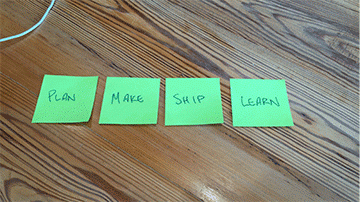Published March 23, 2015 | Updated February 4, 2019 | 29 minute read
These are the big and thorny problems at the heart of why your organization exists today, and why your organization might still exist tomorrow.
We live in a world that is defined by exponential change and inescapable uncertainty.
In industry after industry we are witnessing monumental leaps forward in the cost/performance ratio of underlying technologies. This point has become a common refrain, and is convincingly argued by Salim Ismael in “Exponential Organizations”, by Andrew McAffee and Erik Brynjolfsson in “The Second Machine Age”, and by Peter Diamandis and Steven Kotler in “Abundance”. For example, the cost/performance ratio of drone technology has improved by 142x within the past 6 years. Sensors have improved by 250x in the last 5 years. And the price of DNA sequencing has dropped by a whopping 10,000x in the last 7 years. And these are just a small selection of all the technologies, businesses, and industries being touched and transformed by the phenomenon identified by Ray Kurzweil as The Law of Accelerating Returns, which essentially states that as soon as a core aspect of something becomes digitized it hitches a ride on the exponential growth curve of Moore’s Law.
This relentless and accelerating pace of change has made it impossible to predict the future. Five year plans are now a fool’s errand. Rigorous analysis, decades of experience, and detailed roadmaps are now a liability. The very things that enabled the most successful organizations to thrive in the 20th century are now the very things that cause organizations to fail.
As reported by Deloitte’s Shift Index analysis, the historically aligned economic indicators of labor productivity and return on assets have diverged; i.e. we’ve never been more productive, yet, it’s never been more difficult to get out more than you put in. According to a study by Innosight Lead Director Richard N. Foster, the average lifespan of the S&P 500 has dropped from 61 years in 1958 to 15 years today. And, perhaps most importantly, most people hate their jobs; according to Gallup’s State of the Global Workforce study, only 13% of workers say that they are engaged, while 63% are not engaged, and 24% are actively disengaged.
The reason for this collective organizational FAIL is that organizations optimized for predictability are inadvertently designed to fracture and founder in the face of uncertainty.
For many people, this isn’t news. But, I think it’s even more important than people realize, and here’s why…
Technology is arguably the most powerful force shaping our world today, for better and for worse (in many cases we don’t even know which, yet); andtechnology is changing our world faster than we can comprehend. At the same time, the challenges and opportunities faced by humanity have never been bigger. The continued progress of humanity depends on our ability to harness this unpredictable change for the better.
And even as technology enables fewer people to have a larger impact with fewer resources, massive change is still the work of organized groups of people working together for a common purpose. In the immortal words of Margaret Mead, “Never underestimate the power of a small group of committed people to change the world. In fact, it is the only thing that ever has.”
This is why my mission in life is to help organizations who are trying to change the world for the better successfully navigate our uncertain future.
Here are the questions that I think are most critical to charting that unpredictable course forward.
What’s our purpose?
What is our ‘massive transformative purpose’? How does our shared purpose guide decisions and shape culture? How does our mission bring people — both inside and outside the organization — together?

Now, more than ever, organizations with the ambition to change the world need more than just money to rally others to their cause. Competition for top talent has never been more fierce. The challenges and opportunities created by technology are massive. And having a transformative impact on the world depends on creating something that’s bigger than just your customers, your partners, your employees, and bigger than your organization itself.
When done well, the answers to this question possess an elegant simplicity. Yet, getting there can be incredibly messy. Many large, old organizations face powerful headwinds. Decades, even centuries, of organizational evolution has led them away from purpose in pursuit of profit; often, this is why they’ve lasted so long. Rediscovering their purpose now can be a painful process. One of the Hall of Fame moments in this type of purpose pivot is Apple in 1997, when Steve Jobs famously returned to the company and drastically altered the focus and raison d’être of the company. Jobs brought a reinvigorating purpose back to Apple, and set it on a new course that has made it the most successful company of the next 20 years by almost every measure.
If finding your purpose was easy, it wouldn’t matter. It’s precisely because truly committing to a single visionary mission is so difficult that when you finally find one it can fuel your success for decades to come.
for example…
Google: “Organize the world’s information and make it universally accessible and useful.”
Khan Academy: “Provide a free, world‑class education for anyone, anywhere.”
Singularity University: “Positively impact one billion people.”
How do we cultivate connectedness without discouraging autonomy?
How do we enable people to work in a way that facilitates knowledge sharing, while also empowering people to take action without waiting for approval or asking for permission? How do we balance collaboration with independence? How do we create an empowered network instead of a controlling hierarchy?



In order to sense and respond quickly to the needs of customers and to new opportunities that arise, teams need to be small, nimble, and able to act with minimal dependence on others outside their team. Yet, large organizations depend on leveraging shared knowledge, access to capital equipment, facilities, markets, partners, and more to reach large numbers of users and customers. In the attempt to create efficiencies and economies of scale, we also create interdependencies that slow us down.
Today’s leading organizations build intelligent systems, interfaces, and dashboards, and use social software that allow information to flow freely among members of the organization without requiring a top-down control. By deliberately distributing authority out to the edges of an organization, while also helping everyone to work in public, you get the benefits of both networks and empowerment.
for example…
Companies like Medium and Zappos are doing this by adopting a new organizing system called Holacracy.
OKRs (objectives and key results), originated at Intel and made popular by Google, can be a powerful process for unpacking an organization’s collective purpose, and aligning team-level missions across the company.
How do globally distributed teams work together?
How do teams collaborate seamlessly across time and place? What’s the best way to leverage new tools like chat, video, mobile, and whatever’s next? How can we make conference calls *not suck*?

Geographically distributed teams are becoming more of the norm than the exception. Whether you’re working across dozens of large international headquarters, or satellite regions within the same country, or a distributed team of people who each work from home, or a completely decentralized crowd of freelancers, you have to figure out how to overcome the challenges of not being in the same room with your collaborators.
It’s hard to keep up with all the potential new solutions. Cisco will tell you that their enterprise telepresence system is the ultimate experience. Skype and Google Hangout will tell you that their products are almost as good, and only a fraction of the cost (or completely free). And new startups go from brand new to billion-dollar businesses seemingly overnight.
These tools, however, are just that: tools. Like a hammer, it’s not the tool itself that’s important, but rather what you do with it. In the right hands, a well-designed tool can transform how a team functions. But, these new tools are most effective when they’re part of a broader evolution in how your organization operates.
While there is no one-size-fits-all solution for every organization, there is a growing stack of services that can be combined with behavioral and cultural change to build the right solution for each organization.
for example…
How do we learn faster?
How do we speed up our experimentation/iteration cycle? How do we get people to start by *doing* instead of planning? How do we push our bias for action beyond its assumed limits?
The only way to learn is to try things and see what happens. So, if you truly want to learn faster, you have to be willing to experiment more frequently, and find a way to turn fast failure into rapid learning.

People who are familiar with agile software development already know that this is how things should be done. And other disciplines — from science to lean manufacturing — have applied the same philosophy to tackle problems where the answer is unknown and unpredictable.
Now that our entire world is unpredictable, this same model of test and learn should apply to nearly everything we do. Whether you’re a marketer responsible for launching a new product, an HR leader responsible for updating compensation policy, or an operations leader who’s thinking about reorganizing teams, you can find ways to ship your work earlier, so that you can collect feedback, learn, and adjust.
Working in an organization that understands this new mindset feels completely different from the typical corporate environment. Meetings are maniacally focused on action and accountability. Responsibilities and expectations are documented and shared publicly. When new ideas are brought to the table, it is assumed that the person bringing it has already put the idea in front of real users, and collected validating feedback.
Once you get it, it becomes addictive. You become allergic to passive phrases like “what if we…” and “somebody should…”. You default to taking action, and expect everyone around you to do the same.
With so much self-directed action, you inevitably get failures, too. This is why it’s critical that your company not only embrace failure, but also re-frame failure as learning. Every company that’s an innovative leader in their industry today has a huge appetite for risk, and encourages its employees to try and fail relentlessly and continuously, in the service of faster learning.
for example…
- SpaceX’s spectacular failures at attempting to create a reusable rocket:
- In describing what’s behind BuzzFeed’s incredible success with video content, their President of Motion Pictures, Ze Frank, recently wrote:
We believe that the future of content is wide open, and that this future will be formed out of experimentation, learning, and play. We will need many people working on this problem from diverse perspectives and using a variety of approaches, and this means that whenever possible we will lean into autonomy with purpose rather than the old model of command-and-control–style management.
The faster you can get your ideas in contact with the real world, the faster you can discover what is broken with your idea. Seeking out contact with the real world means hearing and seeing things you don’t want to hear and see — because they’re discouraging and disheartening when you’re pouring your all into something. But better to learn that after a few days then after a few months. The more work you do before you get the learning, the more painful the learning will be, and the more you’ll unconsciously avoid those learning moments.
How do we get responsive ways of working to stick?
How do we get everyone to embrace agile methods beyond just software development? How do we stay lean? How do we reprogram the ways we meet and the ways we make decisions?
How do we get responsive ways of working to spread?
How do we select the stuff that’s working in one place, and replicate it across the organization? How do people learn from each other? How does our culture shape the way we work, and vice versa?
How do we get responsive ways of working to scale?
How do we get the benefits of being decentralized without losing focus? How do people learn new ways to work as we grow and add new people to our organization? How do we organize a network of hundreds or thousands of small, agile teams?

How an organization thinks is only the beginning. How an organization behaves, though, is what truly separates the leaders from the followers. You can’t be a new kind of company unless you operate like one.
Over the past decade, it has become apparent that there is a completely new operating model at work inside the leading organizations that shape our world. They are guided by a visionary purpose (see above). They have a relentless bias for action, and organize in a way that empowers people instead of controlling them. Their path forward emerges from relentless experimentation instead of from careful planning. They default to making information open and accessible instead of private. These organizations face an uncertain world with an antifragile capacity to sense and adapt to the changes around them.
At Undercurrent, we refer to these organizations and the way they work as “responsive”. And we are not alone in identifying this shift.
Adopting these adaptive approaches to how you organize and how you work is the only way to not be left behind by the accelerating changes we face. Many savvy startups have the benefit of building these ways of working into their culture from day 1, simply by intuition. Older organizations, on the other hand, have to learn how to evolve their culture to suit these new values and behaviors. And once you’ve found a version of this new approach that fits your organization, you need to ensure that it spreads. All members of the organization, across functions, regions, and disciplines, need to work from the same playbook. Finally, you have to take these ways of working that are designed to maximize the impact of small, 5–10 person, independent teams, and scale them across dozens, hundreds, thousands, or even tens of thousands of teams.
This new way of working is more than just an operating model, it’s an operating culture.
for example…
Which new technology should we bet on?
Which new technologies will be the most transformative for what we do? How will our business and the lives of our users and customers be transformed by technology? Which technology will unlock exponential success?

If technology has become so essential to how any business stays relevant, and the pace of technological innovation is so rapid, then an organization’s capacity to discover and invent new applications for emerging technologies has to be treated as a critical function. Research and development is no longer a luxury or even a strategic choice; it is the lifeblood of any 21st century organization.
When things get better at an exponential pace, things that seemed far fetched one day can be game-changing the next. 3D printing that seemed relegated to plastic tchotchkes one day can be on the verge of revolutionizing the aviation industry less than 2 years later. A power storage industry that seemed stalled one day can suddenly be the reason for a multi-billion dollar factory (PDF). Self-driving cars that seemed like science fiction one day could be on the verge of taking over our roads a decade later.
The courageous exploration of the frontiers of innovation is an absolute necessity. There is no other way to keep up.
Leading organizations embrace the unknown. They commit to pursuing a broad long-term vision while simultaneously pursuing many, specific near-term experiments.
for example…
Amazon 1997 Letter to Shareholders (PDF)
Google Founder’s IPO Letter, 2004 and this in depth profile on Google X
What’s our platform?
How can our core product enable new products and services to emerge? How do we address a specific need today, while building the foundation to solve many related needs tomorrow? How do we become the backbone of a vast and growing ecosystem of other businesses and their users and customers?

While this tends to be an advanced move, building a platform that supports a thriving community is becoming the surest way to future-proof your company. When done well, your customers actively improve your product along with you. Netflix, one of Amazon Web Service’s biggest customers, is continually optimizing how the platform delivers streaming video. Amazon adopts these improvements and introduces them as valuable upgrades for all its other customers. GitHub only employs a few hundred employees, but its platform empowers a community of over 6 million developers working on over 15 million projects. Founded just 7 years ago, AirBnB now provides more places to stay than any hotel chain in the world.
And this is only the beginning. The economic consequences of this shift are huge. Digitized markets default to a winner-take-all platform in every category. We will quickly discover that this means the practical end of competition in areas where platforms dominate.
Building a platform isn’t easy, but it will be the difference between footnotes and legends in tomorrow’s history books (or Wikipedia entries).
for example…
A few decades ago the defining strategic questions asked within large, complex organizations centered on efficiency, defending your market position, reducing or managing costs, and reliable execution. Today’s key strategic questions focus on how an organization evolves and adapts quickly to the world around it.
It’s no accident that companies like Apple, Google, Amazon, Tesla, and Facebook have achieved such exponential growth. The companies we see today that are defining our world and setting the bar for competitors in their industry have good answers to these questions. But, whether the answers come to you intuitively or you have to work at them, having good answersto these questions is the definition of good strategy in the digital age.
If you care about making the future of work more human and changing the way organizations operate, subscribe to our weekly newsletter and get in touch.


.jpg)







